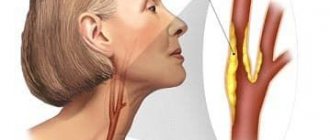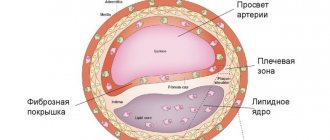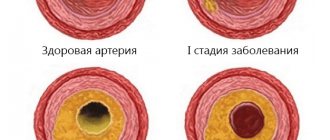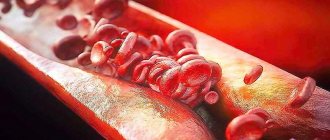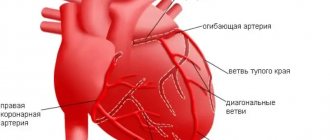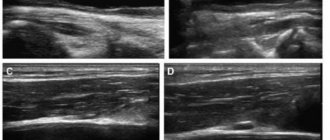Atherosclerosis is called the most common disease of humanity, but it depends only on ourselves to what degree of destruction we will subject our cardiovascular system. The disease is caused by excess cholesterol accumulating in medium and large arteries. If you watch your diet, don’t give in to stress and exercise regularly, you will most likely avoid serious damage to your blood vessels and be able to keep their walls toned. If you do not have the opportunity to carefully adhere to a healthy lifestyle, and you still notice negative changes in your body, contact a professional specialist as soon as possible. Modern diagnostic methods used in the CBCP clinic will help identify vascular atherosclerosis at an early stage, and doctors will select treatment that will protect you from unpleasant complications.
How does the disease appear?
In general, cholesterol (a type of fat) is important for the body, as it participates in the construction of vascular walls and is part of hormones and vitamins. In normal metabolism, cholesterol circulates between the liver and tissues; in excess, it is utilized in the liver. If the circulation is impaired, it accumulates in the form of plaques (together with fibrin and other substances) on the walls of blood vessels. The lumen of the vessel narrows, and the blood pressure on the walls automatically increases. Unfortunately, the process is almost inevitable and is observed in 85% of cases in patients over 50 years of age.
The following phenomena gradually develop:
- the walls of the vessel are subject to ulceration;
- scar tissue grows;
- deposits of lime salts are observed on the vascular walls.
The vessel at the site of plaque formation becomes calcified, and this leads to its destruction.
Conclusion
Atherosclerosis of the coronary vessels is a disease that results from an unhealthy lifestyle, so it is necessary to adjust your diet, establish a daily routine, and also introduce daily physical activity.
As noted earlier, it is extremely difficult to completely avoid this disease and standard treatment with statins inhibits the performance of the most important vitamins D and K2 for humans, which leads to a complete loss of vascular elasticity, so it is important to receive additional doses of these substances from the outside. For example, Osteo K2 completely covers the amount of vitamin D and K2 necessary for the elasticity of the vascular wall, even when taking statins.
Atherosclerosis of cerebral vessels
A form of disease in which atherosclerotic plaques appear in the blood vessels of the brain. The immediate consequence may be a stroke. Various cerebral vessels are affected: brachiocephalic trunk, carotid arteries.
In some cases, atherosclerosis of cerebral vessels occurs without any special symptoms, even if the artery is narrowed by 50%. The patient experiences tinnitus, dizziness, headaches of varying intensity, and sleep disturbances. Gradually, these signs complement hand tremors, memory deterioration, and decreased performance.
Symptoms of cerebral atherosclerosis at a late stage:
- partial memory loss;
- deterioration of thinking abilities;
- numbness of limbs, tongue;
- difficulties in self-care.
The patient periodically experiences conditions similar to a stroke - transient ischemic attacks. When the vessel is completely blocked, an ischemic stroke occurs - brain cells begin to die from lack of oxygen. Another manifestation is a rapid hemorrhagic stroke, which is not expressed by blockage of an artery, but by hemorrhage in the brain. Complications of the disease are extremely difficult to treat: malignant tumors, dementia, etc.
Prevention
Lost health due to atherosclerosis is the result of your attitude towards yourself at random, therefore, already having such a disease, you must at least now be more attentive to yourself and be sure to carry out prevention. In case of OASNK, it is necessary to choose spacious, comfortable shoes to avoid calluses, bruises, avoid any injuries to the legs, and when sitting, do not cross your legs over each other, because At the same time, the vessels are pinched and the blood supply to the affected leg is disrupted. It is necessary to take walks every day; it is very good for your legs. This also includes proper nutrition with the exception of animal fats, salt, smoked meats, fried, red meat, full-fat milk, and cream.
It is necessary to normalize weight and control blood pressure - the numbers should not exceed 140/85. Reducing blood lipids will protect you from myocardial infarction; eliminating physical inactivity from your daily routine and introducing moderate physical activity will also be useful. Quitting smoking is mandatory (this alone reduces the mortality rate from 54% to 18%). It is better to avoid alcohol in any dose.
It is necessary to promptly treat any chronic diseases, control blood sugar levels, avoid stress, regularly visit a doctor for examinations, and systematically conduct courses of conservative treatment. The prognosis is determined by the presence of other forms of atherosclerosis in the vicinity: cerebral, coronary - which, of course, do not improve health.
Atherosclerosis of heart vessels
Atherosclerotic plaques can also form in the coronary vessels, which are responsible for supplying blood to the heart muscle. As a result, the flow of oxygen and nutrients is disrupted, disturbances in the functioning of the heart are noted - chronic ischemic disease develops.
The patient feels:
- frequent pain in the heart area;
- cold extremities;
- increased blood pressure;
- memory and concentration problems;
- lethargy, drowsiness.
In some cases, atherosclerosis of the heart vessels develops against the background of diabetes mellitus and kidney disease. Diagnosing it is difficult, since the first signs may appear when the vessel is already almost completely blocked by plaque. Therefore, if you feel unwell and observe the symptoms listed above, if there is even the slightest suspicion, consult a doctor. This type of disease is one of the common causes of myocardial infarction.
Diagnostic methods
Diagnosis of multifocal atherosclerosis is an important stage, thanks to which it is possible to determine the localization of the pathological focus and the stage of the disease. For this purpose, instrumental and laboratory techniques are used to monitor the condition of blood vessels. These include:
- initial examination and medical history, identification of typical symptoms;
- palpation (palpation) of all superficial arteries located under the skin, as well as listening to them in areas accessible for diagnosis;
- determining the degree of filling of blood arteries and their integrity;
- blood test with mandatory determination of various types of fats and their percentages, including cholesterol;
- radiography, ultrasound examination – basic techniques;
- Dopplerography is an assessment of the conductivity of blood vessels at any part of their passage, using a contrast agent.
When diagnosing atherosclerosis, it is important to determine the location of the pathological area. And also in the process it is possible to differentiate this disease from many chronic diseases of the heart and blood vessels, which manifest themselves with a similar set of symptoms.
Obliterating atherosclerosis of leg vessels
Atherosclerosis of the renal arteries
The formation of an atherosclerotic plaque at the mouth of the renal artery is a common cause of the development of renovascular hypertension. The pathology has characteristic symptoms that can help identify the disorder at an early stage:
- high blood pressure;
- headaches and dizziness;
- shortness of breath due to strain on the heart;
- kidney dysfunction;
- Laboratory tests reveal protein in the urine.
The danger of the disease is that vascular thrombosis can develop, and if both kidneys are affected, a malignant tumor can develop. Only timely diagnosis using modern methods will protect you from dangers.
Atherosclerosis of the mesenteric arteries
Mesenteric arteries are responsible for the blood supply to the intestines, and the formation of atherosclerotic plaques in them leads to serious digestive disorders. As a result, the blood supply needs of the gastrointestinal tract cannot be satisfied.
The signs of vascular atherosclerosis in this case are quite obvious:
- pain in the upper abdomen;
- bloating, constipation, belching;
- nausea and vomiting with bile;
- retention of stool, gases;
- blood in the stool.
This type (popularly called abdominal toad) is similar in symptoms to peptic ulcers, but the pain goes away faster, especially if you take nitroglycerin, and is not relieved with soda. The pain can wander in different areas of the abdomen, often concentrating around the navel. Patients note a general deterioration in their condition, a slight increase in temperature.
Complications include thrombosis of mesenteric vessels, intestinal gangrene with signs of peritonitis.
Atherosclerosis of the arteries of the lower extremities
In the lower extremities, plaques most often form in places where large vessels branch. The superficial femoral and popliteal arteries are usually affected.
This type of disease has several obvious manifestations:
- lameness that appears when you start walking and disappears when you stop;
- pain in the calf muscles, thigh, hip joint;
- at the site of joint damage, the shade of the skin changes (cyanosis);
- there is chilliness in the legs, numbness, cramps at night;
- legs get tired quickly when walking even short distances.
Failure to see a doctor in a timely manner can lead to complete blockage of one of the vessels, which is fraught with complications. The most serious is the development of ischemic gangrene (death of tissue near the affected vessel) - in this case, even amputation of the limb may be necessary.
A common complication is also thrombosis of the arteries of the lower extremities, which leads to embolism: part of the blood clot breaks off and blocks one of the large vessels. It is impossible to predict exactly where the blood clot will go and which vessel it will block.
Symptoms
The danger of developing the disease is that it can manifest itself extremely weakly until the plaque blocks two-thirds of the vascular lumen or begins to collapse, and blood clots from it begin to clog smaller vessels. Then the clinical symptoms become noticeable to the patient.
Manifestations of the disease and treatment depend on the location of formation of atherosclerotic plaques. For example, if the vessels of the brain are affected, the symptoms and treatment will differ significantly from atherosclerosis of the lower extremities.
Even the pathology of the same large vessel is not uniform in its symptoms. In particular, atherosclerosis of the thoracic aorta is manifested by burning pain in the chest, which radiates to the neck, back, abdomen and can last for days. The patient has difficulty swallowing, his voice is hoarse, and the patient himself experiences dizziness and faintness.
And atherosclerosis of the abdominal aorta is characterized by abdominal pain, bloating, and frequent constipation. If the aorta is damaged at the site of division into branches, the patient begins to limp, feels coldness in the lower extremities, and experiences problems with potency.
Treatment
Treatment of obliterating atherosclerosis is carried out taking into account the stage of circulatory disorders. Measures to change lifestyle and diet will be required.
- The patient is required to categorically quit smoking.
- In terms of nutrition, you will have to introduce a low-cholesterol diet with limited consumption of fatty foods, meat, and light carbohydrates.
- It is necessary to observe hygienic foot care (wash your feet twice a day, wipe with a disinfectant solution, change socks more often).
- You should wear comfortable loose shoes, use woolen socks for insulation, and avoid hypothermia. Even minor injuries (cuts, calluses, rubbing) can be dangerous.
You can read more about nutrition principles in this article.
The need for warmth is not a whim, but a real need for the patient
Medicines are conservative methods of therapy and are prescribed only by a doctor. They have to:
- cause dilatation of arterial vessels;
- promote the development of collateral (auxiliary) blood circulation;
- prevent further development of atherosclerosis;
- improve microcirculation at the tissue level.
Variable factors
The development of all types of disease is influenced by our lifestyle. In order to reduce risks as much as possible, you should:
- move more and exercise;
- do not abuse fatty foods;
- try not to expose yourself to stress;
- give up alcohol and smoking.
Potentially correctable causes include:
- diabetes mellitus (glucose levels must be monitored);
- arterial hypertension (pressure);
- hypercholesterolemia (cholesterol levels);
- obesity (waist more than 102 cm in men and more than 88 cm in women);
- frequent infections and intoxications.
When is the use of conservative methods justified?
Vascular surgeons warn about the danger of delaying conservative methods in the presence of severe obliteration of blood vessels and the threat of trophic changes and gangrene.
A course of drug therapy is allowed for:
- stages of chronic arterial insufficiency;
- accompanying severe diseases (myocardial and cerebral ischemia, diabetes mellitus, chronic kidney and lung diseases);
- multilevel vascular lesions with occlusion of the main and terminal arteries.
Complications
The main complication is acute or chronic vascular insufficiency of one or another internal organ. It leads to the gradual death or degeneration of part of its tissues. These phenomena are caused by a lack of oxygen and nutrients. Connective tissue grows in the organ, and sclerotic processes develop.
The second important complication is acute blockage of a vessel by an overgrown atherosclerotic plaque or its detached part - a thrombus. Consequences – acute organ ischemia, myocardial infarction.
At the site of plaque formation, an aneurysm may occur - a vascular formation in which the walls of the vessel bulge and become thinner. An increase in blood pressure caused by physical or psychological stress can provoke aneurysm rupture and intense internal bleeding.
In addition, certain types of pathology cause various complications:
- atherosclerosis of cerebral vessels - stroke, memory loss, dementia;
- atherosclerosis of heart vessels - angina pectoris, arrhythmia;
- atherosclerosis of mesenteric arteries – intestinal necrosis;
- atherosclerosis of the renal arteries - problems with urination and impotence;
- atherosclerosis of the arteries of the lower extremities - trophic ulcers, gangrene.
Timely treatment for symptoms of vascular atherosclerosis
Treatment of pathology is especially effective in the early stages. If you consult a doctor in a timely manner, you can completely get rid of the symptoms of the disease and minimize the negative consequences.
An important role in treatment is played by the qualifications of the doctor and the class of equipment used in the clinic. Modern diagnostic equipment detects even minor changes in the vascular system, and treatment of complex cases is possible without surgical intervention - using innovative, low-traumatic methods.
